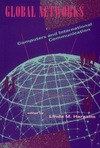Global Networks takes up the host of issues raised by the new networking technology that now links individuals, groups, and organizations in different countries and on different continents. The twenty-one contributions focus on the implementation, application, and impact of computer-mediated communication in a global context.
Previously limited to scientific research, global networks now have an impact on social, educational, and business communications. Individuals with a personal computer, a modem, and some simple software can join a new social community that is based on interest, not location. Global Networks, which was written largely with the assistance of the internet, provides an understanding of the issues, opportunities, and pitfalls of this new social connectivity. It looks at how -networking technology can support and augment communication and collaboration from such perspectives as policy constraints and opportunities, language differences, cross-cultural communication, and social network design.
Linda M. Harasim is a Professor in the Department ofCommunications at Simon Fraser University.
Contributors: Linda M. Harasim. John Quarterman. Howard Rheingold. Anne Branscomb. Lee Sproull and Sara Kiesler. Marvin Manheim. Hiroshi Ishii. Jan Walls. Michael Kirby and Catherine Murray. Andrew Feenberg. Robin Mason. Margaret Riel. Beryl Bellman, Alex Jeffrey Shapard. Lucio Teles. Howard Frederick. Mitchell Kapor and Daniel Weitzner. Shumpei Kumon and lzurni Aizu. Robert Jacobson.
 |
|
О проекте
|
|
О проекте


